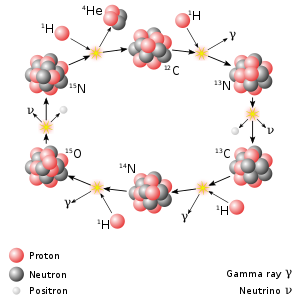The CNO cycle (for carbon–nitrogen–oxygen; sometimes called Bethe–Weizsäcker cycle after Hans Albrecht Bethe and Carl Friedrich von Weizsäcker) is one of the two known sets of fusion reactions by which stars convert hydrogen to helium, the other being the proton–proton chain reaction (p-p cycle), which is more efficient at the Sun's core temperature. The CNO cycle is hypothesized to be dominant in stars that are more than 1.3 times as massive as the Sun.[1]
Unlike the proton-proton reaction, which consumes all its constituents, the CNO cycle is a catalytic cycle. In the CNO cycle, four protons fuse, using carbon, nitrogen, and oxygen isotopes as catalysts, each of which is consumed at one step of the CNO cycle, but re-generated in a later step. The end product is one alpha particle (a stable helium nucleus), two positrons, and two electron neutrinos.
There are various alternative paths and catalysts involved in the CNO cycles, all these cycles have the same net result:
- 4 1
1H
+ 2
e−- → 4
2He
+ 2
e+
+ 2
e−
+ 2
ν
e + 3
γ
+ 24.7 MeV - → 4
2He
+ 2
ν
e + 7
γ
+ 26.7 MeV
- → 4
The positrons will almost instantly annihilate with electrons, releasing energy in the form of gamma rays. The neutrinos escape from the star carrying away some energy.[2] One nucleus goes on to become carbon, nitrogen, and oxygen isotopes through a number of transformations in an endless loop.
The proton–proton chain is more prominent in stars the mass of the Sun or less. This difference stems from temperature dependency differences between the two reactions; pp-chain reaction starts at temperatures around 4×106 K[3] (4 megakelvin), making it the dominant energy source in smaller stars. A self-maintaining CNO chain starts at approximately 15×106 K, but its energy output rises much more rapidly with increasing temperatures[1] so that it becomes the dominant source of energy at approximately 17×106 K.[4]
The Sun has a core temperature of around 15.7×106 K, and only 1.7% of 4
He
nuclei produced in the Sun are born in the CNO cycle.
The CNO-I process was independently proposed by Carl von Weizsäcker[5][6] and Hans Bethe[7][8] in the late 1930s.
The first reports of the experimental detection of the neutrinos produced by the CNO cycle in the Sun were published in 2020. This was also the first experimental confirmation that the Sun had a CNO cycle, that the proposed magnitude of the cycle was accurate, and that von Weizsäcker and Bethe were correct.[2][9][10]


0 Comments